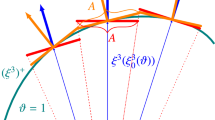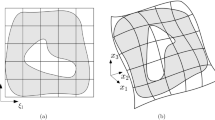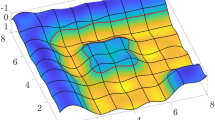Abstract
Very good results in infinitesimal and finite strain analysis of shells are achieved by combining either the enhanced-metric technique or the selective-reduced integration for the in-plane shear energy and an assumed natural strain technique (ANS) in a non-symmetric Petrov–Galerkin arrangement which complies with the patch-test. A recovery of the original Wilson incompatible mode element is shown for the trial functions in the in-plane components. As a beneficial side-effect, Newton–Raphson convergence behavior for non-linear problems is improved with respect to symmetric formulations. Transverse-shear and in-plane patch tests are satisfied while distorted-mesh accuracy is higher than with symmetric formulations. Classical test functions with assumed-metric components are required for compatibility reasons. Verification tests are performed with advantageous comparisons being observed in all of them. Applications to large displacement elasticity and finite strain plasticity are shown with both low sensitivity to mesh distortion and (relatively) high accuracy. A equilibrium-consistent (and consistently linearized) updated-Lagrangian algorithm is proposed and tested. Concerning the time-step dependency, it was found that the consistent updated-Lagrangian algorithm is nearly time-step independent and can replace the multiplicative plasticity approach if only moderate elastic strains are present, as is the case of most metals.
Similar content being viewed by others
References
Andelfinger U, Ramm E (1993) EAS-elements for two-dimensional, three-dimensional, plate and shell structures and their equivalence to HR-elements. Int J Numer Methods Eng 36: 1311–1337
Antman SS (2005) Nonlinear problems of elasticity, 2nd edn. Springer, New York
Antman SS, Marlow RS (1991) Material constraints, lagrange multipliers, and compatibility. Arch Ration Mech Anal 116: 257–299
Areias P. Simplas. https://ssm7.ae.uiuc.edu:80/simplas
Areias P, Belytschko T (2006) Analysis of finite strain anisotropic elastoplastic fracture in thin plates and shells. J Aerosp Eng 19(4): 259–270
Areias P, César de Sá JMA, Conceição António CA, Fernandes AA (2003) Analysis of 3D problems using a new enhanced strain hexahedral element. Int J Numer Methods Eng 58: 1637–1682
Areias P, Dias-da-Costa D, Pires EB, Infante Barbosa J (2012) A new semi-implicit formulation for multiple-surface flow rules in multiplicative plasticity. Comput Mech 49: 545–564
Areias P, Garção J, Pires EB, Infante Barbosa J (2011) Exact corotational shell for finite strains and fracture. Comput Mech 48: 385–406
Areias P, Rabczuk T (2010) Smooth finite strain plasticity with nonlocal pressure support. Int J Numer Methods Eng 81: 106–134
Areias P, Ritto-Corrêa M, Martins JAC (2010) Finite strain plasticity, the stress condition and a complete shell model. Comput Mech 45: 189–209
Areias P, Song J-H, Belytschko T (2005) A finite-strain quadrilateral shell element based on discrete kirchhoff-love constraints. Int J Numer Methods Eng 64: 1166–1206
Bathe K-J, Dvorkin EN (1986) A formulation of general shell elements-the use of mixed interpolation of tensorial components. Int J Numer Methods Eng 22: 697–722
Belytschko T, Liu WK, Moran B (2000) Nonlinear finite elements for continua and structures. Wiley, New York
Belytschko T, Wong BL (1989) Assumed strain stabilization procedure for the 9-node Lagrance shell element. Int J Numer Methods Eng 28: 385–414
Birkhoff G, Schultz MH, Varga RS (1968) Piecewise Hermite interpolation in one and two variables with applications to partial differential equations. Numer Math 11: 232–256
Brank B, Ibrahimbegovic A (2001) On the relation between different parametrizations of finite rotations for shells. Eng Comput 18: 950–973
Bruhns OT, Meyers A, Xiao H (2004) On non-corotational rates of oldroyd’s type and relevant issues in rate constitutive formulations. P R Soc Lond A Math 460: 909–928
Chen C, Mangasarian OL (1995) Smoothing methods for convex inequalities and linear complementarity problems. Math Program 71(1): 51–69
Ciarlet PG (1991) Finite element methods (Part I). In: Ciarlet PG, Lions JL (eds) Handbook of numerical analysis, vol 2. North-Holland, Amsterdam
Crisfield MA, Peng X (1996) Instabilities induced by coarse meshes for a nonlinear shell problem. Eng Comput 13(6): 110–114
Dvorkin EN, Bathe KJ (1984) A continuum mechanics based four node shell element for general nonlinear analysis. Eng Comput 1: 77–88
Eriksson A, Pacoste C (2002) Element formulation and numerical techniques for stability problems in shells. Comput Methods Appl Meach 191: 3775–3810
Felippa CA (2006) Supernatural QUAD4: a template formulation. Comput Methods Appl Meach 195: 5316–5342
Flores FG, Oñate E (2011) Wrinkling and folding analysis of elastic membranes using an enhanced rotation-free shell triangular element. Finite Elem Anal Des 47: 982–990
Hauptmann R, Doll S, Harnau M, Schweizerhof K (2001) Solid-shell elements with linear and quadratic shape functions at large deformations with near incompressible materials. Comput Struct 79: 1671–1685
Holzapfel GA (2000) Nonlinear solid mechanics: a continuum approach for engineers. Wiley, New York
Hughes TJR (2000) The finite element method. Dover Publications, Mineola. Reprint of Prentice-Hall edition, 1987
Hughes TJR, Liu WK (1981) Nonlinear finite element analysis of shells: part I: three-dimensional shells. Comput Methods Appl Meach 26: 331–362
Korelc J (2002) Multi-language and multi-environment generation of nonlinear finite element codes. Eng Comput 18(4): 312–327
Korelc J, Wriggers P (1997) Improved enhanced strain four-node element with Taylor expansion of the shape functions. Int J Numer Methods Eng 40: 407–421
Lee NS, Bathe KJ (1993) Effects of element distortions on the performance of isoparametric elements. Int J Numer Methods Eng 36: 3553–3576
Liu WK, Guo Y, Belytschko T (1998) A multiple-quadrature eight-node hexahedral finite element for large deformation elastoplastic analysis. Comput Methods Appl Meach 154: 69–132
Liu WK, Hu Y-K, Belytschko T (1994) Multiple quadrature underintegrated finite elements. Int J Numer Methods Eng 37: 3263–3289
MacNeal RH, Harder RL (1985) A proposed standard set of problems to test finite element accuracy. Finite Elem Anal Des 1: 1–20
Ogden RW (1997) Non-linear elastic deformations. Dover Publications, Mineola
Ooi ET, Rajendran S, Yeo JH (2004) A 20-node hexahedron element with enhanced distortion tolerance. Int J Numer Methods Eng 60: 2501–2530
Park KC, Stanley GM (1986) A curved C0 shell element based on assumed natural-coordinate strains. J Appl Mech-ASME 53: 278–290
Pian THH, Sumihara K (1984) Rational approach for assumed stress finite elements. Int J Numer Methods Eng 20: 1685–1695
Piltner R, Taylor RL (1995) A quadrilateral mixed finite element with two enhanced strain modes. Int J Numer Methods Eng 38: 1783–1808
Rajendran S, Liew KM (2003) A novel unsymmetric 8-node plane element immune to mesh distortion under a quadratic field. Int J Numer Methods Eng 58: 1718–1748
Ramm E (1982) The Riks/Wempner approach—an extension of the displacement control method in nonlinear analyses. In: Recent advances in non-linear computational mechanics, chap 3. Pineridge Press Limited, Swansea, pp 63–86
Sansour C, Bocko J (1998) On hybrid stress, hybrid strain and enhanced strain finite element formulations for a geometrically exact shell theory with drilling degrees of freedom. Int J Numer Methods Eng 43(1): 175–192
Sansour C, Kollmann FG (2000) Families of 4-node and 9-node finite elements for a finite deformation shell theory. an assessment of hybrid stress, hybrid strain and enhanced strain elements. Comput Mech 24: 435–447
Schoop H, Hornig J, Wenzel T (2002) Remarks on Raasch’s hook. Tech Mech 4(22): 259–270
Simo JC, Armero F (1992) Geometrically non-linear enhanced strain mixed methods and the method of incompatible modes. Int J Numer Methods Eng 33: 1413–1449
Simo JC, Fox DD, Rifai MS (December 1989) Geometrically exact stress resultant shell models: formulation and computational aspects of the nonlinear theory. In: Noor AK, Belytschko T, Simo JC (eds) Analytical and computational models of shells. vol 3 of CED. ASME, San Francisco, pp 161–190
Simo JC, Hughes TJR (2000) Computational inelasticity. Springer, New York. Corrected second printing edition
Sze KY, Kim YS, Soh AK (1997) A hybrid stress quadrilateral shell element with full rotational DOFS. Int J Numer Methods Eng 40: 1785–1800
Truesdell C, Noll W (2004) The non-linear field theories of mechanics, 3rd edn. Springer, New York
Wolfram Research Inc (2007) Mathematica
Wagner W, Klinkel S, Gruttmann F (2002) Elastic and plastic analysis of thin-walled structures using improved hexahedral elements. Comput Struct 80: 857–869
Wilson EL, Taylor RL, Doherty WP, Ghaboussi J (1973) Incompatible displacement models. In: Fenves SJ, Perrone N, Robinson AR, Schnobrich WC (eds) Numerical and computer models in structural mechanics. Academic Press, New York, pp 43–57
Wu C-C, Huang Y-Q, Ramm E (2001) A further study of incompatible models: revise-stiffness approach and completeness of trial functions. Comput Methods Appl Meach 190: 5923–5934
Author information
Authors and Affiliations
Corresponding author
Rights and permissions
About this article
Cite this article
Areias, P., Dias-da-Costa, D., Pires, E.B. et al. Asymmetric quadrilateral shell elements for finite strains. Comput Mech 52, 81–97 (2013). https://doi.org/10.1007/s00466-012-0799-2
Received:
Accepted:
Published:
Issue Date:
DOI: https://doi.org/10.1007/s00466-012-0799-2




